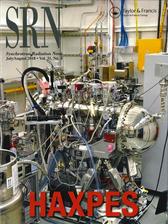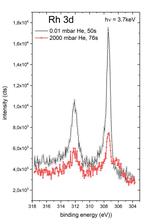The POLARIS Instrument featuring on the cover of the Synchrotron Radiation News (July/August 2018, Vol31 No.4)
Experiments at POLARIS are run exclusively in collaboration with the Group of Anders Nilsson (Martin Beye as of September 2023) at Stockholm University. Please get in touch well in advance with the beam line staff and the Nilsson Group prior to proposal submission, specially if you require unlisted gases!
The POLARIS setup is dedicated to investigate catalytic processes on surfaces and interfaces under realistic conditions; i.e., pressures of 0,2-1 bar and beyond, and temperatures up to 700°C during the measurement.
The study of chemical processes in operando conditions is an important field of materials science. HAXPES is expected to provide valuable insights towards an understanding of catalytic chemical transformations at interfaces between solids and liquids or gases. The key requirement here is to probe the catalytic surfaces operando, i.e. under industrially relevant conditions, in order to detect intermediates or the chemical state of the catalyst during the catalytic cycle. For this purpose, the ambient-pressure HAXPES setup POLARIS has been developed by the group of Anders Nilsson at Stockholm University. The instrument is stationed at P22 and was commissioned in the spring of 2018, and it is profoundly described in the list of publications provided below.
Example of Rh 3d spectra measured during the initial commissioning of the instrument in April 2018. Spectra were recorded at a Helium pressure of 0.01 and 2000 mbar. Please note the short acquisition times.
POLARIS is based on a R4000-Hipp2 electron spectrometer (Scienta Omicron) which combines a high-resolution electron analyzer with a differentially pumped pre-lens system to effectively separate the high-pressure regime from the vacuum necessary to run the detector. Windowless operation of the instrument at pressures around and beyond 1 bar is achieved by the so-called front-cone, which replaces the widely used noozles in typical ambient pressure setups (single aperture larger than 100μm radius). In addition to smaller apertures (around 10 in the order of 10μm radius), the frontcone implements also the inlet of the gas, allowing to create the virtuall cell characteristic of Polaris and achieving significantly higher sample pressures. Two high-precision manipulators allow positioning the sample in 6 degrees of freedom with sub-μm resolution with respect to the front cone and the X-ray beam. During high pressure mode, temperatures up to 700oC can be obtained using p-BN encapsulated heaters. HAXPES measurements have been achieved at pressures up to 2,5 bar using He and temperatures up to 450°C, allowing for the study of catalytic reactions under real conditions while the catalytic surface is turning over the reaction.
The POLARIS instrument current allows for standard sputtering and annealing of samples, without structural characterization at the moment. It can accommodate an electrochemical cell and offers additional ports for dedicated feedthroughs. In addition to photoemission, formation of products can be followed with a residual gas analyzer being placed in the second differential pumping section of the electron analyzer.
To the moment, the following gases can be employed at Polaris: inerts (CO2, N2), noble gases (He, Ar), hydrocarbons (CH4, C2H4), NO, CO and H2. Additional gases may be allowed after consultation with.
Experiments at POLARIS are run exclusively in collaboration with the Group of Anders Nilsson (Martin Beye as of September 2023) at Stockholm University. Please get in touch well in advance with the beam line staff and the Nilsson Group prior to proposal submission, specially if you require unlisted gases!
List of publications (updated 05.07.2023)
[1] D. Degerman et al., ‘State of the Surface During CO Hydrogenation over Ni(111) and Ni(211) Probed by Operando X-ray Photoelectron Spectroscopy’, J. Phys. Chem. C (2023).
[2] M. Shipilin et al., ‘In Situ Surface-Sensitive Investigation of Multiple Carbon Phases on Fe(110) in the Fischer–Tropsch Synthesis’, ACS Catal. (2022).
[3] P. Amann et al., ‘The state of zinc in methanol synthesis over a Zn/ZnO/Cu(211) model catalyst’, Science (2022).
[4] D. Degerman et al., ‘Operando X-ray Photoelectron Spectroscopy for High-Pressure Catalysis Research Using the POLARIS Endstation’, Synchrotron Radiation News (2022).
[5] D. Degerman et al., ‘Operando Observation of Oxygenated Intermediates during CO Hydrogenation on Rh Single Crystals’, J. Am. Chem. Soc. (2022).
[6] H. Wang et al., ‘Direct Evidence of Subsurface Oxygen Formation in Oxide‐Derived Cu by X‐ray Photoelectron Spectroscopy’, Angewandte Chemie (2022).
[7] J. Knudsen et al., ‘Stroboscopic operando spectroscopy of the dynamics in heterogeneous catalysis by event-averaging’, Nat Commun. (2021).
[8] S. Blomberg et al., ‘Bridging the Pressure Gap in CO Oxidation’, ACS Catal. (2021).
[9] C. M. Goodwin et al., ‘The Structure of the Active Pd State During Catalytic Carbon Monoxide Oxidization’, J. Phys. Chem. Lett. (2021).
[10] C. M. Goodwin et al., ‘A Novel Method to Maintain the Sample Position and Pressure in Differentially Pumped Systems Below the Resolution Limit of Optical Microscopy Techniques’, Appl Spectrosc (2020).
[11] P. Amann et al., ‘A high-pressure x-ray photoelectron spectroscopy instrument for studies of industrially relevant catalytic reactions at pressures of several bars’, Review of Scientific Instruments (2019).








